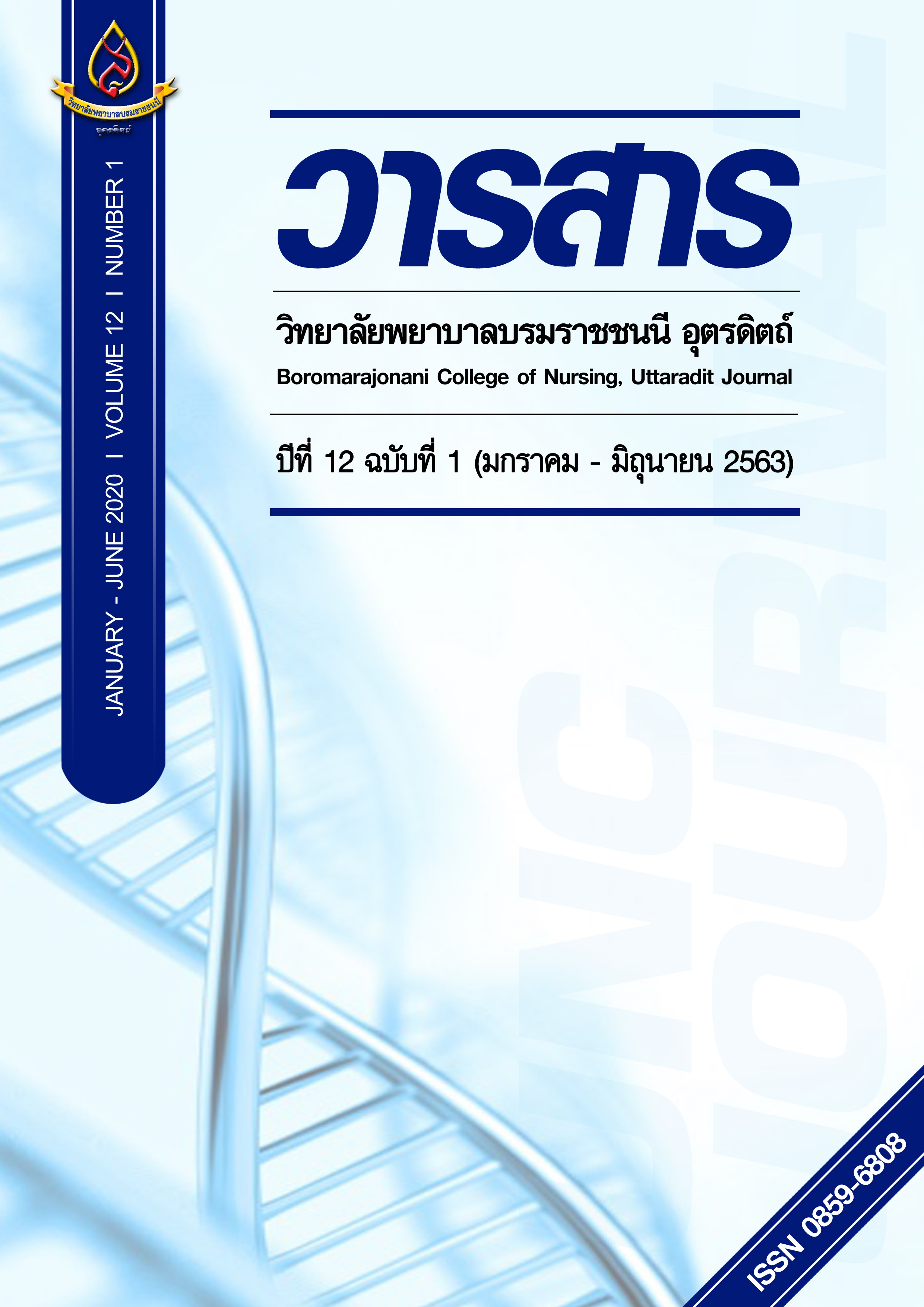ความสัมพันธ์ระหว่างความรอบรู้ด้านสุขภาพกับพฤติกรรมการดูแลตนเองและอัตราการกรองของไตในผู้ป่วยโรคไตเรื้อรังระยะที่ 3 – 4
Main Article Content
บทคัดย่อ
การวิจัยครั้งนี้ เป็นการวิจัยเชิงบรรยายความสัมพันธ์ เพื่อศึกษาความสัมพันธ์ระหว่างความรอบรู้ด้านสุขภาพกับพฤติกรรมการดูแลตนเองและอัตราการกรองของไตในผู้ป่วยโรคไตเรื้อรังระยะที่ 3 – 4 โดยใช้ทฤษฏีความรอบรู้ด้านสุขภาพเป็นกรอบแนวคิด กลุ่มตัวอย่างเป็นผู้เป็นโรคไตเรื้อรังระยะที่ 3 – 4 ที่มารับบริการที่แผนกผู้ป่วยนอก โรงพยาบาลนพรัตน์ราชธานี กรุงเทพมหานคร ระหว่างเดือนพฤษภาคม – มิถุนายน 2561 คัดเลือกกลุ่มตัวอย่างแบบเฉพาะเจาะจงตามคุณสมบัติที่กำหนด จำนวน 97 ราย เครื่องมือที่ใช้เป็นแบบวัดความรอบรู้ด้านสุขภาพและแบบประเมินพฤติกรรมการดูแลตนเองของผู้เป็นโรคไตเรื้อรัง วิเคราะห์ข้อมูลโดยใช้สถิติเชิงพรรณนาและสถิติสหสัมพันธ์สเปียร์แมน (Spearman rank order correlation)
ผลการวิจัยพบว่า กลุ่มตัวอย่างส่วนใหญ่มีพฤติกรรมการดูแลตนเองโดยรวมอยู่ในระดับปานกลาง คะแนนเฉลี่ยความรอบรู้ด้านสุขภาพโดยรวมอยู่ในระดับปานกลาง ความรอบรู้สุขภาพด้านความเข้าใจ ด้านการเข้าถึงข้อมูล ด้านทักษะการสื่อสารและด้านการรู้เท่าทันสื่ออยู่ในระดับปานกลาง และมีความรอบรู้ด้านสุขภาพด้านการจัดการตนเองและด้านทักษะการตัดสินใจอยู่ในระดับสูง มีความรอบรู้ด้านสุขภาพที่ไม่เหมาะสม 5 อันดับแรกคือ การรับประทานน้ำในผู้ป่วยโรคไตเรื้อรังระยะที่ 4 การรับประทานน้ำในผู้ป่วยโรคไตเรื้อรังระยะที่ 3 การค้นหาและเลือกแหล่งข้อมูลสุขภาพเกี่ยวกับการปฏิบัติตน การรับประทานยาสมุนไพรหรืออาหารเสริม และการโน้มน้าวให้บุคคลอื่นยอมรับข้อมูลเกี่ยวกับการปฏิบัติตน โดยความรอบรู้ด้านสุขภาพมีความสัมพันธ์ทางบวกกับพฤติกรรมการดูแลตนเอง และมีความสัมพันธ์ทางลบกับอัตราการกรองของไต
ผลการศึกษาสามารถนำไปใช้เป็นข้อมูลแนวทางส่งเสริมความรอบรู้ด้านสุขภาพ ในผู้เป็นโรคไตระยะที่ 3- 4 ให้มีพฤติกรรมการดูแลตนเองที่เหมาะสม ชะลอการลดลงของอัตราการกรองของไต ลดการเข้าสู่โรคไตเรื้อรังระยะสุดท้าย
Article Details
บทความหรือข้อคิดเห็นใดใดที่ปรากฏในวารสารวิจัยการพยาบาลและวิทยาศาสตร์สุขภาพ เป็นวรรณกรรมของผู้เขียน ซึ่งบรรณาธิการหรือสมาคมศิษย์เก่า ไม่จำเป็นต้องเห็นด้วย และบทความที่ได้รับการตีพิมพ์เผยแพร่ถือเป็นลิขสิทธิ์ของวารสารวิจัยการพยาบาลและวิทยาศาสตร์สุขภาพ
เอกสารอ้างอิง
Arammuang, S. , Sangkard, K., Kimpee, S. & Sriyuktasuth, A. (2012). Factors predicting fluid control behavior in chronic kidney disease patients receiving hemodialysis. Journal of Nursing Science , 30(3), 74-81. (in Thai)
Berkman, N.D. et al. (2011) .Low health literacy and health outcome : an update systemic review. Annals of Internal Medicine. 155(2), 97-107.
Center for disease control and prevention (CDC). (2017).Chronic kidney disease surveillance system. Retrieved (2017, March 9) from: https://www.cdc.gov/ckd.
Cho, Y.I., Lee, S.Y.D., Arozullah, A.M., & Crittenden, K.S. (2008). Effects of health literacy on health status and health service utilization amongst the elderly. Social Science and Medicine, 66(8), 1809-1816.
Coleman, C. (2011).Teaching health care professional about health literacy. Nurse Outlook, 59(2), 70-78.
Devraj, R., Borrego, M., Vilay, A.M., Gordon, E.J., Pailden, J., & Horowit, B. (2015). Relationship between health literacy and kidney function. Nephrology (Carlton), 20(5), 360–367.
Health Education Division, Department of Health Service Support, Ministry of Public Health, (2013). Promoting and assing health literacy and health behavior (ABCDE – Health Literacy Scale of Thai Adults). Bangkok: n.d. ( in Thai)
Hlakhew, A. & Chalikheru, T. (2015). Health literacy and factors related to medication among patients with hypertension Ban Piang Luang Subdistrict health promoting hospital, Chiang Mai Province. Academic report and presentation of research results National and international level 6,national group Science, 1(6), 635-649. (in Thai)
Isaacs, B., & Kennie, A. T. (1973). The set test as an aid to the detection of dementia in old people. The British Journal of Psychiatry, 123(575), 467-470.
Ingsathit, A., Thakkinstian, A., Chaiprasert, A. Sangthawan, P., Gojaseni, P., Kiattisunthorn, K., et al. (2010). Thai-SEEK Group. Prevalence and risk factors of chronic kidney disease in the Thai adult population: Thai SEEK study. Nephrology Dialysis Transplantion, 25(5), 1567-1575.
Jitchan, P. , Masingboon, K, & Duanpaeng, S. ( 2011). Predictors of functional performance in patients with chronic kidney disease. Thai Journal of Nursing Council, 26(2), 86- 99. (in Thai)
Kidney Disease: Improving global outcomes.(2017) KDIGO 2017 Clinical practice guidelineupdate for the diagnosis, evaluation, prevention, and treatment of chronic kidney disease–mineral and bone disorder (CKD-MBD). Kidney International Supplements. 7(1), 1- 59.
Lee, S.J., & Jeon, J .(2015). Relationship between symptom clusters and quality of life in patients at stages 2 to 4 chronic kidney disease in Korea. Apple Nursing Research, 28(4), 113 -119
Maneesri, S., Sangkard,K0 , Pongthawronsakol, K. & Terapornlaterat, K. (2011). Factors influencing Self- mangment in chronic kidney disease patients. Vajira Nursing Journal, 13(1), 14-27.(in Thai)
Nutbeam, D. (2008). The evolving concept to health literacy. Social Science and Medicine, 67, 2072 – 2078.
Tangsanga, K. (2011). Chonic kidney disease. Bangkok: Text and Journal Publication. (in Thai)
Taiwong, A., Kanogsunthornrat, N. & Chaiviboonthum, S. ( 2017). Relationship between unpleasant symptom clusters and quality of life among patients with chronic kidney disease. Journal of Nursing and Health Care, 35(3), 120-128. (in Thai)
The National Institute of Diabetes and Digestive and Kidney Diseases. (2016). Department of health and human services national institutes of health. Retrieved (2017, March 9) from: https://www.cdc.gov/diabetes/pdfs/data/statistics/national-diabetes-statistics-report.pdf
The Office of Policy and Strategic Plan.(2015). Health Statistics Year 2014. Bangkok: The War Veterans Organization of Thailand. (in Thai)
Thummaphol, P.,Piaseu,N. & Jarupat-Maruo,S. (2018). Health literacy and clinical outcomes in people with hypertension, dyslipidemia and type 2 diabetes mellitus. Journal of Nursing and Health Care, 34(3), 176-182. (in Thai)


